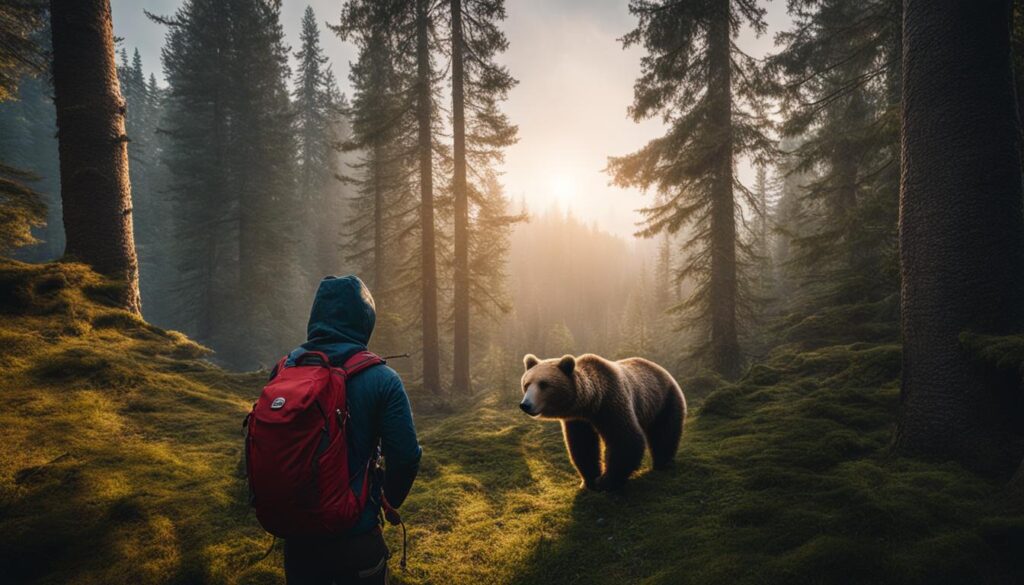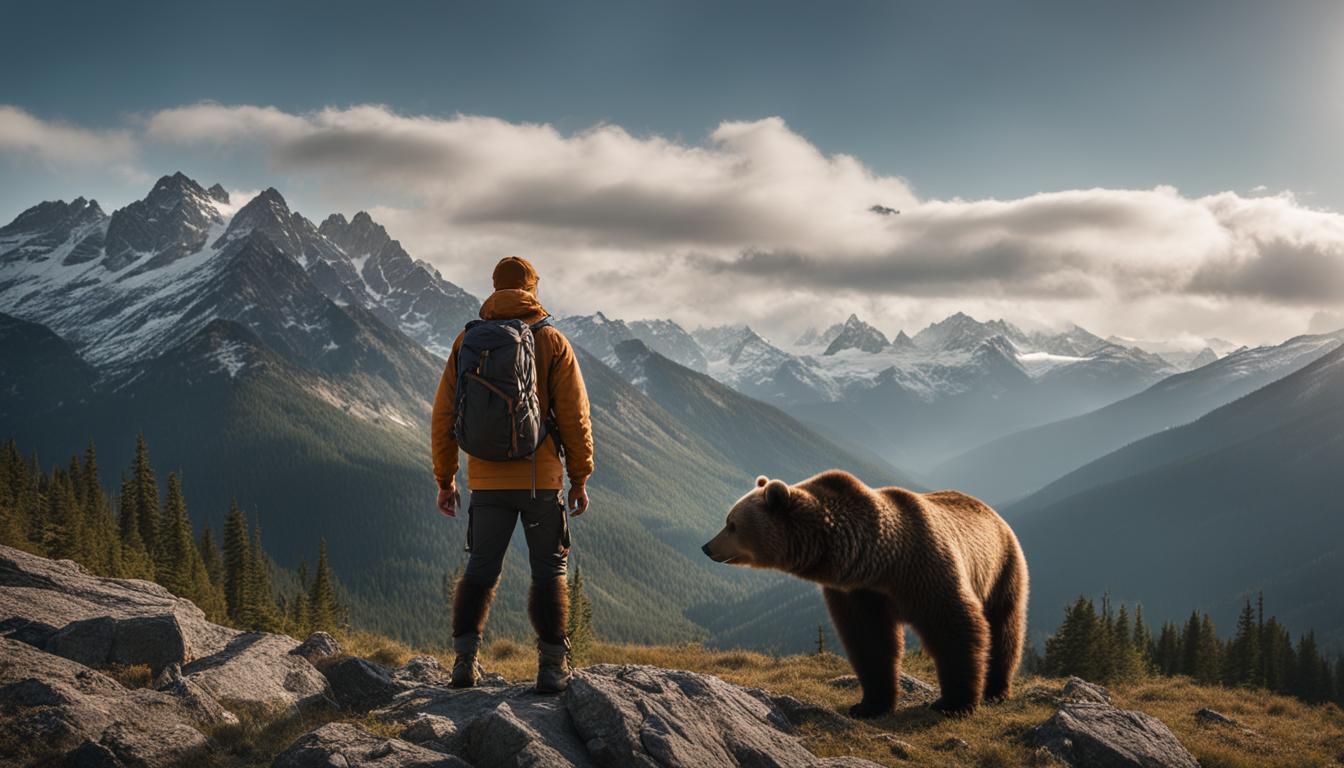Educating myself about wildlife behavior is crucial for a safer backpacking experience. Before embarking on any adventure, I make sure to research and understand the types of wildlife that are present in the area. This knowledge allows me to take necessary precautions to prevent dangerous encounters.
When it comes to wildlife safety tips, there are a few key things I always keep in mind. Firstly, I avoid any actions that may encourage wildlife, such as feeding or approaching them too closely. By respecting their space, I minimize the risk of negative interactions. Secondly, I practice responsible hiking etiquette by staying on designated trails. This helps protect the natural habitat and ensures I don’t inadvertently disturb wildlife.
Being aware of my surroundings is also crucial. I make sure to keep an eye out for signs of wildlife presence, such as tracks and droppings. Making noise while hiking, especially in areas with limited visibility, helps alert animals of my presence and reduces the likelihood of surprising them.
Lastly, I always hike in small groups whenever possible. Not only is it more enjoyable to share the experience with others, but it also enhances safety. Larger groups tend to make more noise, making wildlife aware of our presence from a greater distance.
Key Takeaways
- Research and understand the types of wildlife in the area before backpacking.
- Avoid actions that may encourage wildlife, such as feeding or approaching too closely.
- Practice responsible hiking etiquette by staying on designated trails.
- Be aware of your surroundings and make noise to alert animals of your presence.
- Hike in small groups to enhance safety and make more noise.
Safety Tips for Wildlife Encounters

When it comes to encountering wildlife while backpacking, there are several general safety tips to keep in mind. Firstly, it is important to remember that most wildlife naturally wants to avoid humans. If you do come across wildlife, remaining calm and walking rather than running is crucial to avoid triggering a predatory response. It is also recommended to educate oneself about the types of wildlife that may be present in the region and to keep an eye out for signs of their presence, such as tracks and droppings. In the case of encountering a bear, making noise to alert them of your presence and carrying bear spray can be effective deterrents. Additionally, proper food storage and following Leave No Trace principles can help reduce the risk of bear encounters. When it comes to encountering snakes, being vigilant on the trail and giving them space to move off is important. If bitten, it is essential to seek immediate medical attention. For encounters with mountain lions, staying calm, making yourself appear large, and slowly backing away can help ensure safety.
Remember, most wildlife wants to avoid humans. Stay calm and walk, don’t run. Educate yourself about the types of wildlife in the area and watch out for signs of their presence. Use bear spray and make noise to deter bears. Be vigilant and give snakes space. Seek medical attention if bitten. Stay calm, make yourself appear large, and slowly back away when encountering mountain lions.
Safety Tips for Bear Encounters
| Black Bears | Grizzly Bears | |
|---|---|---|
| Behavior | Usually avoids humans unless attracted to food | Can be defensive and aggressive if threatened |
| Prevention | Carry bear spray, make noise, properly store food | Carry bear spray, make noise, properly store food |
| Encounter | Stay calm, make noise, slowly back away | Stay calm, play dead, fight back if attacked |
Safety Tips for Snake Encounters
| Venomous Snakes | Non-venomous Snakes | |
|---|---|---|
| Behavior | Venomous bite poses a risk to humans | No venom, pose minimal threat to humans |
| Prevention | Be vigilant on the trail, give them space to move off | Be vigilant on the trail, give them space to move off |
| Response | Seek immediate medical attention if bitten | Non-venomous, no immediate medical attention required |
Safety Tips for Mountain Lion Encounters
| Mountain Lions | |
|---|---|
| Behavior | Typically avoid confrontations with humans |
| Prevention | Stay calm, make noise, make yourself appear large |
| Response | Slowly back away, do not turn your back, fight back if attacked |
Tips for Specific Wildlife Encounters
When it comes to encountering snakes while backpacking, it’s important to stay calm and keep a safe distance. Allow the snake to move away on its own and avoid making sudden movements that could startle it. If you come across a rattlesnake, back away slowly and give it the space it needs. In the unfortunate event of a snake bite, it’s crucial to seek immediate medical attention for proper treatment.
When it comes to bear encounters, it’s essential to know the difference between grizzly bears and black bears and understand their behaviors. To minimize the risk of bear encounters, make noise while hiking to alert them of your presence. Traveling in groups is also recommended as bears are less likely to approach larger numbers. Additionally, carrying bear spray can be a highly effective deterrent. If a bear approaches you, stay calm, make yourself appear large, and slowly back away. In rare cases where there is a bear attack, playing dead is the best strategy for grizzly bears, while fighting back is recommended for black bears.
If you happen to encounter a mountain lion, it’s crucial to avoid running as it may trigger a chase response. Instead, maintain eye contact, make yourself appear large, and slowly back away. It’s important not to turn your back on the mountain lion. In the unlikely event of an attack, fight back using any objects or tools you have available. Remember, staying calm and confidently asserting your space can help deter mountain lions and protect your safety.
By understanding the behaviors and following these safety tips for specific wildlife encounters, you can significantly reduce the risk of dangerous situations while backpacking. Stay aware of your surroundings, remain calm, and prioritize your safety at all times.
How Can Understanding Wildlife Behavior Help Backpackers Safely Coexist with Wildlife?
Understanding wildlife behavior is crucial for backpackers hoping to safely coexist with wildlife. By following the principles outlined in the backpacker’s wildlife coexistence guide, such as respecting animal territories and using safe food storage practices, backpackers can minimize the risk of negative wildlife encounters and enjoy a more harmonious wilderness experience.
FAQ
What should I do if I encounter wildlife while backpacking?
Remain calm and walk, rather than run, to avoid triggering a predatory response. Educate yourself about the types of wildlife in the area and be aware of signs of their presence. Make noise to alert animals of your presence and carry bear spray for bear encounters. Give snakes space and seek immediate medical attention if bitten. Remain calm, make yourself appear large, and slowly back away when encountering mountain lions.
How can I prevent bear encounters while backpacking?
Make noise to alert bears of your presence and carry bear spray as a deterrent. Proper food storage and following Leave No Trace principles can also help reduce the risk of bear encounters.
What should I do if a bear approaches me?
Stay calm, make yourself appear large, and slowly back away. In the rare case of a bear attack, play dead if it’s a grizzly bear and fight back if it’s a black bear.
What should I do if I encounter a snake on the trail?
Keep a safe distance and allow the snake to move away. In the case of a rattlesnake, stay calm and back away slowly. Seek immediate medical attention if bitten.
How should I handle encounters with mountain lions?
Avoid running, make yourself appear large, and slowly back away. If attacked, fight back to protect yourself.

